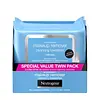What's inside
What's inside
 Key Ingredients
Key Ingredients

No key ingredients
 Benefits
Benefits

 Concerns
Concerns

 Ingredients Side-by-side
Ingredients Side-by-side

Water
Skin ConditioningDicaprylyl Ether
EmollientDecyl Glucoside
CleansingGlyceryl Oleate
EmollientInulin
Skin ConditioningTetrasodium Glutamate Diacetate
Citric Acid
BufferingSodium Citrate
BufferingFructose
HumectantSodium Bicarbonate
AbrasiveTocopheryl Acetate
AntioxidantPanthenol
Skin ConditioningParfum
MaskingPunica Granatum Seed Oil
EmollientCocos Nucifera Oil
MaskingOlea Europaea Fruit Oil
MaskingArgania Spinosa Kernel Oil
EmollientSimmondsia Chinensis Seed Oil
EmollientPersea Gratissima Oil
Skin ConditioningOrbignya Oleifera Seed Oil
EmollientMoringa Oleifera Seed Oil
EmollientSalvia Hispanica Seed Oil
MoisturisingCrambe Abyssinica Seed Oil
Skin ConditioningPhenoxyethanol
PreservativeBenzoic Acid
MaskingDehydroacetic Acid
PreservativeWater, Dicaprylyl Ether, Decyl Glucoside, Glyceryl Oleate, Inulin, Tetrasodium Glutamate Diacetate, Citric Acid, Sodium Citrate, Fructose, Sodium Bicarbonate, Tocopheryl Acetate, Panthenol, Parfum, Punica Granatum Seed Oil, Cocos Nucifera Oil, Olea Europaea Fruit Oil, Argania Spinosa Kernel Oil, Simmondsia Chinensis Seed Oil, Persea Gratissima Oil, Orbignya Oleifera Seed Oil, Moringa Oleifera Seed Oil, Salvia Hispanica Seed Oil, Crambe Abyssinica Seed Oil, Phenoxyethanol, Benzoic Acid, Dehydroacetic Acid
Water
Skin ConditioningCetyl Ethylhexanoate
EmollientIsostearyl Palmitate
EmollientPentaerythrityl Tetraethylhexanoate
EmollientIsononyl Isononanoate
EmollientCyclopentasiloxane
EmollientHexylene Glycol
EmulsifyingPEG-4 Laurate
EmulsifyingPEG-6 Caprylic/Capric Glycerides
EmulsifyingSucrose Cocoate
EmulsifyingCarbomer
Emulsion StabilisingSodium Hydroxide
BufferingBenzoic Acid
MaskingDehydroacetic Acid
PreservativePhenoxyethanol
PreservativeIodopropynyl Butylcarbamate
PreservativeParfum
MaskingWater, Cetyl Ethylhexanoate, Isostearyl Palmitate, Pentaerythrityl Tetraethylhexanoate, Isononyl Isononanoate, Cyclopentasiloxane, Hexylene Glycol, PEG-4 Laurate, PEG-6 Caprylic/Capric Glycerides, Sucrose Cocoate, Carbomer, Sodium Hydroxide, Benzoic Acid, Dehydroacetic Acid, Phenoxyethanol, Iodopropynyl Butylcarbamate, Parfum
 Reviews
Reviews

Ingredients Explained
These ingredients are found in both products.
Ingredients higher up in an ingredient list are typically present in a larger amount.
Benzoic Acid is used to preserve and adjust the pH of products.
The antimicrobial property of Benzoic Acid helps elongate a product's shelf life. Its main role is to reduce fungi growth and is not found to be effective at fighting bacteria. Therefore Benzoic Acid is always added along with other preservatives.
In its pure form, Benzoic Acid looks like a white crystalline solid. It has slight solubility in water.
The name of Benzoic Acid comes from gum benzoin, which used to be the sole source of deriving this ingredient. Benzoic Acid is the most simple aromatic carboxylic acid.
Benzoic Acid is naturally occuring in strawberries, mustard, cinnamon, and cloves. It has a slight scent but is not considered to be a fragrance.
Learn more about Benzoic AcidDehydroacetic Acid is fungicide and bactericide. It is used as a preservative in cosmetics. Preservatives help elongate the shelf life of a product.
Dehydroacetic Acid is not soluble in water.
Parfum is a catch-all term for an ingredient or more that is used to give a scent to products.
Also called "fragrance", this ingredient can be a blend of hundreds of chemicals or plant oils. This means every product with "fragrance" or "parfum" in the ingredients list is a different mixture.
For instance, Habanolide is a proprietary trade name for a specific aroma chemical. When used as a fragrance ingredient in cosmetics, most aroma chemicals fall under the broad labeling category of “FRAGRANCE” or “PARFUM” according to EU and US regulations.
The term 'parfum' or 'fragrance' is not regulated in many countries. In many cases, it is up to the brand to define this term.
For instance, many brands choose to label themselves as "fragrance-free" because they are not using synthetic fragrances. However, their products may still contain ingredients such as essential oils that are considered a fragrance by INCI standards.
One example is Calendula flower extract. Calendula is an essential oil that still imparts a scent or 'fragrance'.
Depending on the blend, the ingredients in the mixture can cause allergies and sensitivities on the skin. Some ingredients that are known EU allergens include linalool and citronellol.
Parfum can also be used to mask or cover an unpleasant scent.
The bottom line is: not all fragrances/parfum/ingredients are created equally. If you are worried about fragrances, we recommend taking a closer look at an ingredient. And of course, we always recommend speaking with a professional.
Learn more about ParfumPhenoxyethanol is a preservative that has germicide, antimicrobial, and aromatic properties. Studies show that phenoxyethanol can prevent microbial growth. By itself, it has a scent that is similar to that of a rose.
It's often used in formulations along with Caprylyl Glycol to preserve the shelf life of products.
Water. It's the most common cosmetic ingredient of all. You'll usually see it at the top of ingredient lists, meaning that it makes up the largest part of the product.
So why is it so popular? Water most often acts as a solvent - this means that it helps dissolve other ingredients into the formulation.
You'll also recognize water as that liquid we all need to stay alive. If you see this, drink a glass of water. Stay hydrated!
Learn more about Water